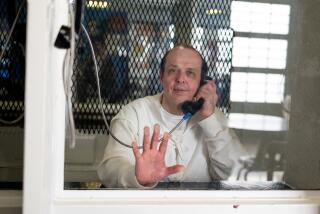RULING HALTS STATE METHOD OF EXECUTION
- Share via
A federal judge in San Jose ruled Friday that California’s application of its lethal injection death penalty procedure violates the constitutional prohibition against cruel and unusual punishment.
The state’s system “is broken, but it can be fixed,” U.S. District Judge Jeremy Fogel said in a 17-page ruling that makes it unlikely that any death sentences will be carried out in California in the near future. The high-profile case had effectively halted executions since February, but Fogel’s ruling left the door open for the resumption of executions by lethal injection if the state comes up with a revised procedure the judge finds constitutionally acceptable.
Fogel’s ruling came the same day that Florida Gov. Jeb Bush declared a halt to executions there in the aftermath of a botched lethal injection this week.
The two actions were the latest development in what is now the central legal issue in the long-running battle over capital punishment in the United States: whether lethal injections are being administered in a humane, constitutional manner. Challenges to lethal injections have resulted in stays of execution in states around the country, and Friday’s developments will probably spur more challenges, legal experts said.
California’s current lethal injection procedure, like that in three dozen other states, calls for a three-drug cocktail. The first drug, sodium thiopental, is a fast-acting barbiturate that is supposed to render the condemned inmate unconscious before the second two drugs -- pancuronium bromide, which paralyzes the body, and potassium chloride, which causes cardiac arrest -- are administered.
Fogel acted in response to a suit filed by lawyers for condemned inmate Michael Morales, who has been on death row for more than 20 years for the brutal slaying of Lodi teenager Terri Winchell. The thrust of Morales’ suit is that the state does not properly administer enough sodium thiopental to ensure that the inmate does not feel excessive pain when the potassium chloride is administered.
Fogel, who visited the death chamber in San Quentin and held a four-day hearing in San Jose in September, said the case generated evidence that “is more than adequate to establish a constitutional violation.”
His decision was replete with stinging criticisms of state officials for failing to take the necessary steps to correct problems in the procedure -- steps the judge urged them to take in February.
“Given that the state is taking a human life, the pervasive lack of professionalism in the implementation” of the lethal injection protocol is “at the very least deeply disturbing,” Fogel wrote.
Morales’ execution was scheduled for February, but the state postponed it after being unable to meet conditions imposed by the judge, who became concerned that the procedure was not working correctly.
“As this court noted” in its February order, “anomalies in six execution logs raise substantial questions as to whether certain inmates may have been conscious when pancuronium bromide or potassium chloride was injected,” Fogel wrote. “These substantial questions remain unanswered.”
Fogel emphasized that Dr. Robert C. Singler, the state’s medical expert, said that another condemned inmate, Robert Lee Massie, “well may have been awake when he was injected with potassium chloride” during his March 27, 2001, execution. Singler testified that he could not render a definitive opinion because of the poor quality of the execution logs. He also testified that it would be “unconscionable” to inject a conscious person with the amount of potassium chloride prescribed by the protocol.
The threshold issue in the case, Fogel said, is whether the procedure, as implemented, “provides constitutionally adequate assurance that condemned inmates will be unconscious when they are injected” with the second and third drugs.
He said “the evidence shows that the protocol” and the state’s implementation of it “suffer from a number of critical deficiencies.”
Among those he cited are:
* Inconsistent and unreliable screening of execution team members. The judge noted that a prison guard led the execution team despite the fact that he was diagnosed with and disabled by post-traumatic stress disorder as a result of his prison experiences, and found working on the execution to be the most stressful responsibility a prison employee could have.
* A lack of meaningful training, supervision and oversight of the execution team. The judge noted that team members “almost uniformly have no knowledge of the nature or properties of the drugs that are used or the risks or potential problems associated with the procedure.”
* Inconsistent and unreliable recordkeeping. The judge said there were “no contemporaneous records showing that all of the sodium thiopental in the syringes used for injections actually was injected, and in fact, testimony revealed that in at least several executions it was not.”
Fogel also said there was “an extremely troubling absence of reliable documentation as to the disposition of sodium thiopental taken from the prison pharmacy by execution team members.” He said that other testimony revealed that the drug, an addictive, controlled substance, was not used in training exercises. Consequently, he said, “these circumstances may warrant an investigation by an appropriate law enforcement agency.”
* Improper mixing, preparation and mixing of sodium thiopental by the execution team.
* Inadequate lighting, overcrowded conditions and poorly designed facilities in which the execution team must work.
In his ruling Friday, Fogel urged Gov. Arnold Schwarzenegger “to take this opportunity to address seriously now, rather than later, the significant problems” with the state’s lethal injection protocol and its implementation.
“Part of the problem,” the judge said, “may be that the prison officials responsible for implementation of the protocol see their legal obligations too narrowly.”
He said that former San Quentin Warden Steven Ornoski testified that “he believes a ‘successful execution’ is simply one where ‘the inmate ends up dead at the end of the process.’ ”
Fogel strongly suggested that the state might want to consider switching to a one-drug procedure, using a heavier dose of a barbiturate such as sodium pentobarbital.
On the particularly thorny issue of whether there must be participation by a doctor, the judge awarded the state a victory.
“Because an execution is not a medical procedure, and its purpose is not to keep the inmate alive but rather to end the inmate’s life, the court agrees” with the state that “the Constitution does not necessarily require the attendance and participation of a medical professional,” Fogel wrote.
Fogel gave California officials 30 days to tell him whether they intend to review and revise the state’s procedure, and, if so, how much additional time they believe they will need to complete the task.
Andrea Lynn Hoch, the governor’s legal affairs secretary, said the administration will review state procedures “to make certain the protocol and its implementation are constitutional.”
“Judge Fogel’s decision is bold and incisive,” said Fordham University law professor Deborah Denno, an expert on methods of punishment. “It is the most comprehensive decision in the country to determine that a state’s lethal injection protocol, in its current form, is intolerable and unconstitutional under the 8th Amendment.”
Morales’ attorneys said they were pleased with the decision. “Judge Fogel has ordered the state to do what we have asserted they should do since the beginning of this litigation -- undertake a considered, searching review of their procedures,” said Ginger Anders, an attorney in Washington, D.C.
The ruling was hailed by groups opposed to capital punishment, including the Campaign to End the Death Penalty, Amnesty International, Human Rights Watch, and Death Penalty Focus of California, whose spokeswoman, Stefanie Faucher said: “It is time for California to stop tinkering with the machinery of death and recognize that the death penalty is a failed public policy which drains valuable resources away from programs that actually increase public safety and serve the needs of victims.”
Attorney Kent Scheidegger, of the Criminal Justice Legal Foundation, a pro-capital punishment group in Sacramento, said it was “unfortunate that there will be further delay in this already grossly overdue execution.”
He also said California ought to analyze whether lethal injection “was the right way to go in the first place” and perhaps consider bringing back the gas chamber, using carbon monoxide rather than cyanide.
Fogel acknowledged that any legal proceeding about the death penalty is a “powerful magnet,” likely to generate impassioned debate about a highly divisive issue. But he cautioned that “this case is not about whether the death penalty makes sense morally or as a matter of policy.” Nor, he said, is it about whether lethal injection is constitutional. Rather, it is about the specific way that California implements its procedure, and in that regard, he said, the state clearly fell short.
*
(BEGIN TEXT OF INFOBOX)
Back story
Michael Morales, the 46-year-old convicted murderer who was the focal point of Friday’s lethal injection ruling, was found guilty of the brutal slaying in 1981 of Terri Winchell, a 17-year-old Lodi high school senior.
Morales admitted conspiring with his cousin, Rick Ortega, to kill Winchell as payback for her dating Ortega’s bisexual lover. He first choked her with a belt, then hit her in the face and head 23 times with a hammer before dragging her from a car, raping her, stabbing her four times and leaving her in a vineyard.
Morales was set to become the 14th man and first Latino executed by the state of California since capital punishment was reinstated in 1978. His scheduled execution prompted new debate over how the state practices capital punishment. His execution was stayed last February only an hour before his scheduled death by injection.
*
(BEGIN TEXT OF INFOBOX)
Ruling on lethal drugs
A federal judge ruled Friday that the procedure that California uses in lethal injections creates a risk that the inmate will suffer extreme pain.
The execution process:
1) About 30 minutes before the execution, the inmate is moved from the holding cell, strapped to a gurney and connected to a cardiac monitor.
The three drugs are in syringes, which are taped to a cart.
2) Intravenous catheters are attached to two sites on the inmate’s body, usually the arms. A saline solution drip to one arm is started from a bag outside and above the chamber.
Lethal drugs
3) After the warden issues the execution order, the syringes containing the three drugs are injected in the IV drip apparatus.
The drugs are:
- Sodium pentothal, also known as sodium thiopental, an anesthetic that induces the person to lose consciousness.
- Pancuronium bromide, a muscle relaxant, paralyzes the diaphragm and stops breathing.
- Potassium chloride, which stops the heart.
Sources: California Department of Corrections and Rehabilitation, www.HowStuffWorks.com, Morales v. Tilton
Graphics reporting by CHERYL BROWNSTEIN-SANTIAGO
More to Read
Sign up for Essential California
The most important California stories and recommendations in your inbox every morning.
You may occasionally receive promotional content from the Los Angeles Times.










